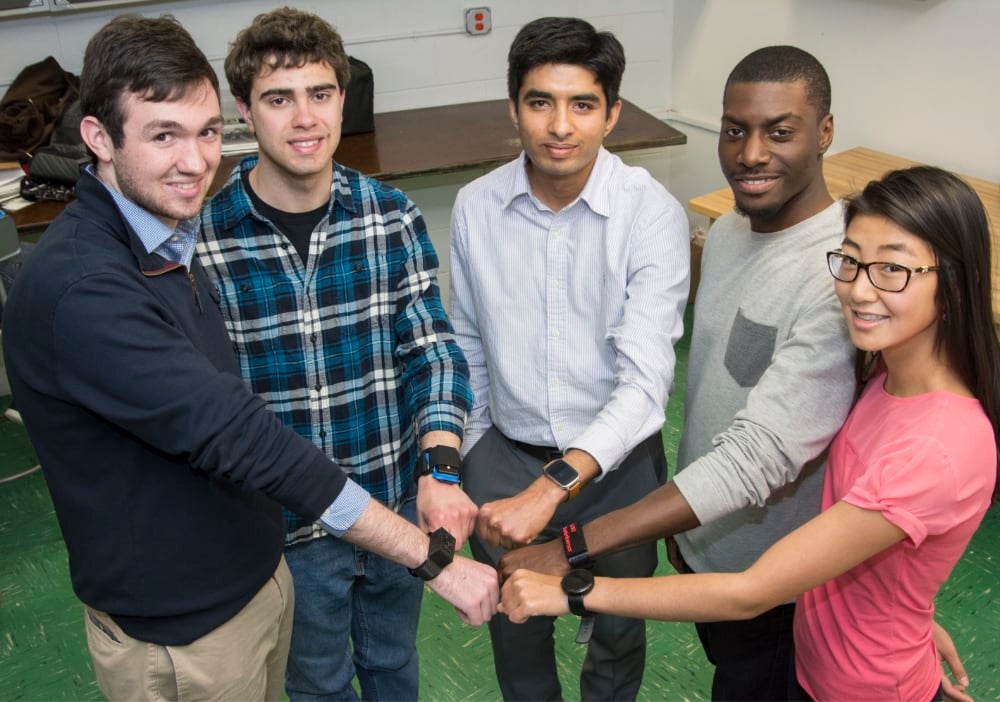KINGSTON, R.I. – April 30, 2015 — For the 4 million people worldwide with Parkinson’s disease, a smart wristband invented by a team of University of Rhode Island engineering students could let them lead healthier lives.
Called TeleTremor, the wristband uses high-tech motion sensors to detect tremors and movement difficulties in people with Parkinson’s disease and sends the information to doctors over a secure Internet connection. Through innovative visualizations, TeleTremor enables neurologists to make more informed decisions by measuring the effect of prescribed medications and the progression of the disease.
Senior biomedical engineering major Trevor Bernier of Taunton, Mass., sophomore computer engineering major Joseph Tudino of Scituate, R.I., and junior electrical engineering major Akintoye Onikoyi of Providence teamed up to design the system and build a prototype, with the assistance of lab technician Tanya Wang.
“We each had different skills and different interests, and we put them together to design this system,” said Onikoyi. “It will help Parkinson’s patients be monitored more frequently from the comfort of their own homes, since they have trouble getting to doctor appointments because of their condition.”
Last month the students garnered international attention for their device as one of 23 finalists at the International Undergraduate Global Health Technologies Design Competition at Rice University in Houston.
Although the project has already met with success, the students are continuing to improve it, including efforts to make it more comfortable to wear, extend the battery life, and develop a better algorithm that will result in more accurate data for use by medical personnel.
“Technology, like wearable devices and smartphones, are often looked at as unnecessary luxuries,” said Bernier, “but I believe that with some creativity and engineering design, these technologies can revolutionize the future of health care.”
The project to develop the device was also a valuable learning experience for the students.
“From this experience, I learned a lot about all the different needs for technological innovations in medicine, especially in developing countries,” said Tudino. “It has made me think about the role of wearable technology and how the technology of the future will be small, subtle, and supplement our lives.”
“TeleTremor is a product of URI’s continuous efforts to nurture excellence, leadership, innovation and real-world experience through collaboration in our next generation of engineers who are acquiring the right skills for today’s highly dynamic marketplace,” said Kunal Mankodiya, URI assistant professor of biomedical engineering who studies wearable biosensors and advised the student team.
Cheryl Resmini, a staff member in the URI Admission Office who has been diagnosed with Parkinson’s, said “Parkinson’s disease affects each individual differently. TeleTremor brings us hope for a more personalized treatment.”
Dr. Lars Wahlberg, chief executive officer of NsGene Inc. and a neurosurgeon at Rhode Island Hospital who provided clinical guidance to the students, said “Technologies such as TeleTremor are what neurologists and other clinicians seek to apply to improve patient monitoring and convenience and change the way we treat people with Parkinson’s disease who may benefit greatly from tech-driven solutions if they are engineered appropriately.”
This is not the first time that Mankodiya and his students have leveraged smart technology to improve patient care. Another team of students is working on a smartwatch system that can monitor vital signs and send the information to doctors over the Internet.

